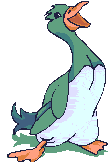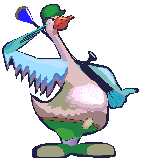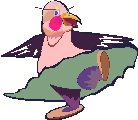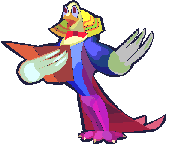|
|
Canku Ota |
|
|
(Many Paths) |
||
|
An Online Newsletter Celebrating Native America |
||
|
December 1, 2001 - Issue 50 |
||
|
|
||
|
Game Birds |
||
|
|
|
|
Game birds offer the most varied and perhaps the most delicious wild meat. Ranging from the rich, tangy flavor of the miniature woodcock up to a magnificent wild turkey or Canada goose, they provide a range of flavor delicacy as wide as the variation of the sport in hunting for them. The quality and flavor of game birds, however, depends to a very large extent, on the care they receive after the hunter has bagged them. The simple rules to follow are these: The birds should be drawn soon after they have been shot. The body heat should be allowed to cool as quickly as possible. The birds should be kept cool or at cold temperatures until they are to be cooked. Game birds should be bled, cleaned and cooled quickly after shooting. And as you clean them, be sure to remove the oil sacs at the base of the back near the tail. Also be sure to carry a portable ice chest to speed cooling and to protect the birds from spoilage during the trip home. When testing game birds to determine those which are young and tender, the stiffness of the bill is usually significant. If pheasants and grouse, for example, can be lifted by the lower jaw and nothing breaks, they are mature birds whose jaws are set. They will not be as tender and will require more cooking than the younger, less developed. Game birds should be skinned if only the breast will be used or if they are tough and will be used in stews or casseroles. Otherwise, the birds should be plucked. This helps keep the meat more moist and tender. Be sure you remove any shot pellets and cut away any badly shot up areas. Cut off the wings and feet of small birds with shears. Then, cut small birds up the backbone, remove the lungs, wash and drain. Cut larger birds into pieces, the same as you would a chicken. You'll also find the livers from medium and large-sized birds are big enough to save and will taste very similar to chicken livers. Here's another hint. Freezing a bird for a week or two will help tenderize it. |
|
|
Stewed Wild Goose |
|
|
|
Ingredients:
1 goose or 2 ducks, cut up
1 potato, cut into large wedges Salt and pepper 1 apple, cut into wedges Bacon drippings Corn meal Water |
|
Directions: |
|
|
Combine all ingredients except corn meal. Cover with water and cook until tender (turning once); discard potato and apple. Mix corn meal and water until mix will pat into dumplings. Add dumplings and cook until done. |
|
|
Stuffed Wild Goose |
|
|
Ingredients:
Giblets from goose
4 cups bread crumbs 2 med. onions 2 apples, diced 1/4 tsp. sage 1/4 tsp. garlic powder 2 tsp. salt 1/2 tsp. pepper 1 med. wild goose 2 tbsp. butter |
|
|
Directions: |
|
|
Cook giblets until tender; reserve liquid. Chop giblets and add to bread crumbs, onions, apples, and seasonings. Add liquid from giblets to moisten stuffing. Place goose in roasting pan and dot with butter. Bake approx. 20 minutes per pound of goose at 350 degrees. Baste often. 8-12 servings. |
|
|
Roasted Pheasant |
|
|
|
Ingredients:
1 pheasant
1 qt. boiling water 1 cup chopped celery Salt and pepper 1 onion, chopped 4 bacon strips 1 cup water |
|
Directions: |
|
|
Clean pheasant. Place in pan and pour boiling water over it and into cavity. Place celery and onion or favorite dressing inside bird; do not sew up or truss. Rub with salt and pepper; place bacon across breast. Add one cup of water for basting and roast in moderate oven (350 degrees F.) for 2 hrs. or until tender. |
|
|
Roasted Quail with Onion Gravy |
|
|
Ingredients:
30 quail, cleaned
Salt Pepper All-purpose flour 8 slices bacon 2 cups peanut oil 1/4 cup all-purpose flour 1 cup water 2/3 cup minced onion Dash of garlic salt |
|
|
Directions: |
|
|
Sprinkle quail with salt and pepper to taste; dredge in flour, and set aside. Fry bacon in a large skillet. Remove bacon, reserve for other uses. Add peanut oil to drippings in skillet; heat over medium heat. Add quail; cook 10-12 minutes on each side or until done. Remove quail from pan; drain on paper towels. Reserve 1/4 cup drippings in pan. Add flour to drippings, stirring until smooth. Cook 1 minute, stirring constantly. Gradually add water, stirring well. Add onion and cook over medium heat, stirring constantly, until thickened and bubbly. Stir in 1/2 tsp. salt, 1/8 tsp pepper, and garlic salt. Yields: 15 servings. |
|
|
|
||
|
|
||
| Canku Ota is a free Newsletter celebrating Native America, its traditions and accomplishments . We do not provide subscriber or visitor names to anyone. Some articles presented in Canku Ota may contain copyright material. We have received appropriate permissions for republishing any articles. Material appearing here is distributed without profit or monetary gain to those who have expressed an interest. This is in accordance with Title 17 U.S.C. section 107. | ||
|
Canku Ota is a copyright © 2000, 2001 of Vicki Lockard and Paul Barry. |
||
|
|
|
|
|
The "Canku Ota - A Newsletter Celebrating Native America" web site and its design is the |
||
|
Copyright © 1999, 2000, 2001 of Paul C. Barry. |
||
|
All Rights Reserved. |
||




